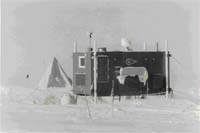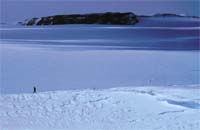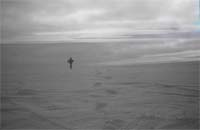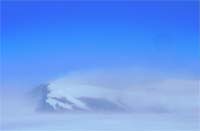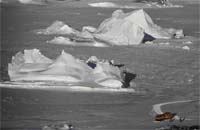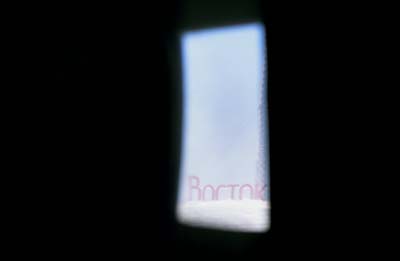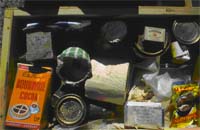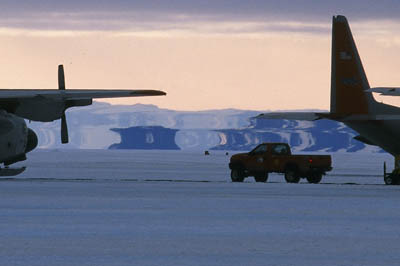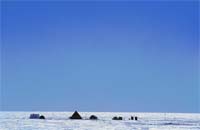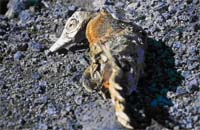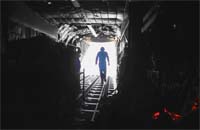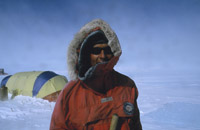Hoosh
from Alimentum, (Winter 2008)

"At lunchtime Mawson compounded a wonderful new hoosh made out of seal liver, pounded up with a geological hammer, and mixed with crushed biscuit."
—Edgeworth David, in The Heart Of The Antarctic
A day before I flew by bush plane into the Transantarctic Mountains for a three month project, my friend Robert Taylor led me quietly into the McMurdo Station kitchen, and surprised me with a dozen loaves of his exquisite bread. A slender, soft-spoken baker with a penchant for mischief, he knew he was helping me escape to the hinterlands with some of the best food in the United States Antarctic Program (USAP). Into my knapsack went bundles of olive, sweet potato, and plain sourdough, moist but with a firm crust, illicitly made and freely given.
"This is beautiful, Robert," I said, "how can I repay you?"
"You can't," he said, and smiled sweetly, "just have a good time, and when you come back tell me some stories."
Ask anyone for stories of Antarctic cuisine, and they're likely to go as blank as the ice continent itself. If they know their history of exploration, however, perhaps they'll speak darkly of seal steaks and breast of penguin. About pemmican and biscuits boiled in tea. About dog flesh and caches of pony meat. About "hoosh," the famous Antarctic soup of meat and melted snow. About scurvy and dying hungry.
All of which shows how a sad state of culinary affairs has been framed by a truly rich history on this terra incognita. Here, at the bitter end of terrestrial exploration, where year-round occupation preceded microwave ovens by only a few years, food has rarely had a more attentive, if helpless, audience. Cold, isolation, and a lack of worldly alternatives have conspired to make Antarctica's captive inhabitants desperate for generally lousy food.
"Cocoa was almost intoxicating and even plain beef suet, such as we had in fragments in our hoosh mixture, had acquired a sweet and aromatic taste scarcely to be described… as different as chalk is from the richest chocolate cream." Or so said the great Antarctic explorer Douglas Mawson, in raptures over the benefits of starvation.
And in the last weeks of his 1907-1909 Nimrod expedition, Ernest Shackleton scrawled very brief diary entries that always noted his group's overpowering hunger:
"Strong following blizzard, and did 14 ½ miles to north. Adams not fit yet. All thinking and talking of food."
"Strong following wind. Did 20 miles 300 yards. Temperature plus 22 degrees Fahr. All thinking and talking of food."
Shackleton's thin hooshes of pemmican (dried beef infused with dried fruit and suet), crushed biscuit, and rancid pony meat could not compensate for the thousands of calories burned daily while hauling their sledge across the snows.
They were trudging back to the coast after a failed attempt to reach the South Pole, each day stretching their rations to the brink of starvation. He and his three companions dreamt, schemed and argued daily about food. They described previous feasts, and fantasized about the banquets they would lay out for each other once they reached civilization. The long marches were also spent inventing new courses for the others to enjoy or critique. At "the high-water mark of gastronomic luxury" was Frank Wild's "Wild roll": a generous portion of mincemeat wrapped in rashers of fat bacon, set into a thick pastry, and fried in a pan full of fat. Shackleton's personal best, "which I must admit I put forward with a good deal of pride as we marched over the snow," was a sardine pasty made with at least ten tins of sardines.
Their calorie-starved bellies grumbled the prayers they spoke each desolate day.
The Secret Society of Unconventional Cooks
"Our rations at this time were as follows: breakfast - 1 mug of penguin and seal hoosh and 1 biscuit; supper 1 ½ mugs of seal, 1 biscuit and ¾ pint of thin cocoa. We were always hungry on this, and to swell the hoosh we used to try putting in seaweed of which quite a lot had been washed upon the beach. When fresh, this was not bad, but most of it had deteriorated in the summer owing to the sun and penguins walking over it."
—Victor Campbell, The Wicked Mate
Shackleton and his adventures are fairly well known today. There are rarer, more unusual stories to tell. Few can tell you anything about the mysterious Rozo, cook for Jean-Baptiste Charcot's 1903-1905 French Antarctic Expedition. No one knew his real name or age. In worn slippers, Rozo padded up and down the corridors of the vessel Francais as it lay frozen into the ice. All through the otherworldly winter, he baked bread three times a week (and perfect croissants each Sunday) for demanding Frenchmen while the dark Antarctic night raged around them. He joined the south-bound expedition in Buenos Aires at the last minute, and disappeared afterward back into his itinerant life, another example of how the soul of the kitchen leaves only a faint trace in the mouth of history.
The Secret Society of Unconventional Cooks was formed among the ranks of Douglas Mawson's 1911-1914 Aurora expedition during their first winter. Each man in the party took his turn working the stove; inexperience was judged less harshly by the Society than was a failure to impress. Frank Hurley's inedible pastry earned him the rank of founding member, because he stiffened his bread for sculptural purposes, "so that it would stand up in the form of a ship or some grotesque shape." Charles Laseron, another founding member, explained that over time, nearly every member of the expedition was "elevated with due ceremony to this aristocracy of chefs… But even to the end there were a few who still ranked as 'crook cooks,' and even gloried in the title."
Working with dough in a rough hut with uneven temperatures (freezing near floor and walls, too hot near the stove and ceiling) became an art mastered by each expedition. Adolf Lindstrom of Roald Amundsen's Fram expedition (1910-1912) made bread and hotcakes in a hut buried beneath the snow of the Ross Ice Shelf. Simultaneously, on nearby Ross Island, T.C. Clissold, Robert Scott's cook on the Terra Nova expedition, placed a small metal disc on top of each rising loaf. This disc closed an electrical circuit as it reached the proper height, setting off an alarm and pulling him back from his other tasks.
And what of Bjarne Lorentzen of the 1949-1952 Norwegian-British-Swedish expedition, who, to the surprise of the men, produced a lovely meal of skua gull "a la ptarmigan in cream sauce," overcoming their opinion that "such inveterate carrion-eaters" weren't fit for human consumption. They never determined if the quality of the meal was due to the attributes of the birds or of the cook.
It Paid for its Cheek with its Life
"The day's march was an extremely heavy five miles; so before turning in I treated myself to an extra supper of jelly soup made from dog sinews."
—Douglas Mawson, Home Of The Blizzard
A quick course in Antarctic cuisine, moreover, shows that such living off the land was de rigueur in the early exploration of the continent. While few of the carnivorous skuas made it to the stove, untold thousands of penguins and penguin eggs (boiled and fried) were consumed by small groups of men scattered across the Antarctic coast. One dark April night in 1912, a banging on the hut door startled Trygvve Gran, giving him the wild notion that Robert Scott had somehow risen from the dead: "I rushed out of the hut into the blizzard. Something loomed up and I ran towards it. Ugh! A big emperor penguin was paying us a visit. It paid for its cheek with its life."
The shipwrecked 1901-1904 Nordenskjold expedition, facing another bleak hungry winter, had just stolen 6000 eggs from an Adelie penguin rookery when their rescuers arrived.
These men were often begrimed by the smoke of seal blubber, which they used as fuel for both stove and lamps. Photos from expedition after expedition show men shooting, gutting, and flaying the fat-rich seals to supply the kitchen or feed the dogs. The 1914-1917 Aurora expedition was so crippled with scurvy (the gums of the survivors protruded black and swollen from their mouths) that upon their return to the coast R. W. Richards "had the strongest desire to rush to one of [the seals] and cut its throat and drink the blood that I knew would hose from its neck."
The menus were often as stark as they were desperate. One seal had in its stomach 36 undigested fish, each one a savior for the six-man Northern Party (of the Terra Nova expedition) through their appalling unplanned winter in a snow cave. Tryggve Gran downed a liter of seal liver and ten-year-old canned peas one evening, and still felt hungry. He also noted that other experiments did not fare so well: "Seal is splendid fried in butter, but fried in penguin fat, as it was tonight, it is dreadful. It was funny to see the different grimaces on the faces of those who had dipped their spoon in this 'pemmican.' Most of them gave the meal a miss - even Wilson, the founder of the feast."
Only the coast provided wild animals to eat. To cope with the vast lifeless Antarctic interior, expeditions brought beasts of burden that often became meat for the hoosh. (This was very much in the tradition of 19th century European expeditions to Africa, Asia, and the Arctic. Pack animals, from camels to yaks, carried and then became fodder.) Few things are as efficient, in the fight for survival, as the ability to eat your transportation. As Douglas Mawson reasoned, "…in an enterprise where human life is always at stake, it is only fair to put forward the consideration that the dogs represent a reserve of food in cases of extreme emergency."
In the Antarctic, ponies and dogs were often fed to dogs and men. On the Nimrod expedition, Shackleton's ponies pulled sledges full of supplies across the great white yonder of the Ross Ice Shelf. The worn-out pony carcasses joined the food and fuel in caches for the men returning from the East Antarctic plateau. Roald Amundsen's party, in their successful bid to be the first to reach the South Pole, slaughtered 24 healthy dogs once they had outlived their usefulness. "Great masses of beautiful fresh, red meat, with quantities of the most tempting fat, lay spread over the snow." Amundsen was a hungry Norwegian epicure, and the dogs' corpses recalled "memories of dishes on which the cutlets were elegantly arranged side by side, with paper frills on the bones, and a neat pile of petit pois in the middle."
Meat and Melted Snow
"The Summit ration was the result of our experiments on the Winter Journey. I expect it is the best ration which has been used to date, and consisted of biscuits 16, pemmican 12, butter 2, cocoa 0.57, sugar 3 and tea 0.86 ounces; total 34.43 ounces daily per man."
—Apsely Cherry-Garrard, Worst Journey In The World
What sustenance had our hardy predecessors brought to Antarctica that they further supplemented with local flesh? On most expeditions, the men spent the winter living relatively luxurious lives in huts on the coast. They ate from hundreds of crates of tinned items, including jams, pickles, and delicacies such as partridge or snowberries. For the actual sledging journeys into the calorie-sucking interior of the continent, however, where nothing awaited them but snow and ice, they brought standardized portions of hard biscuits, pemmican, butter, salt, cocoa and tea. Meals consisted most often of a hoosh made up of whatever portions of these ingredients they figured they could afford to use per day and still make it to the Pole and back. Rarely were their estimates correct. For water they melted snow, and carried great quantities of fuel to do so: even so, they were probably dehydrated for weeks at a time. Although most of the men survived, Antarctica sucked far more life out of them than they would ever slurp from their hoosh.
Hooshes tended to get fairly desperate after a while, on the British journeys at least, and emotions ran high about the quantity and quality of the meals as their starvation diets continued. Edgeworth David, on the 1912 three-man journey to the South Magnetic Pole, wrote that "MacKay detected an unusual flavor in the hoosh, and cross-questioned Mawson severely on the subject. Mawson admitted a lump of sugar. MacKay was thereupon roused to a high pitch of indignation, and stated that this awful state of affairs was the result of going out sledging with 'two foreigners.'" MacKay was British, and the other two Australian, at a time when the difference was noted mostly by the quality of one's tan.
Shackleton invented the all-important game of "Shut-eye" for the fair distribution of portions. Like many games, its invention was intended to prevent war. One man, the cook for that day, would painstakingly pour out equal portions of hoosh into each bowl and then turn his back to the food; another would point to a bowl and say "whose?", and the cook would say one of their names, and so on. This pathetic ritual took place daily in a small green tent on the great white plains of Antarctica, a field of lifelessness that treats the human body like a worm on a wet sidewalk. Shackleton noted in The Heart Of The Antarctic that the men still couldn't help staring at each other's portions: "We look at each other as we eat our scanty meals and feel a distinct grievance if one man manages to make his hoosh last longer than the rest of us…"
For a two- or three-year stint in the Antarctic, they had little in the way of fresh vegetables or fruit. The slow sail from Europe to the Antarctic meant the ruin of anything fresh in the equatorial heat. Butter would turn, and even containers of pickled or canned goods might boil in the tropics. Whatever fresh meat, dairy, or vegetables they picked up in New Zealand or Australia on their way south would not last much beyond the long journey to the continent.
Moreover, the fact that fresh food cured scurvy seemed to have been forgotten by the early 20th century British, even though an 18th century Englishman had proved it 130 years earlier. Captain Cook, bless his soul, ordered his sailors on his 1772-1776 voyages around the globe to fetch fistfuls of anything green and edible on every island they visited, or face punishment. He was the first captain to sail below the Antarctic Circle, and did so without losing a single man to scurvy. But the "adventures" and deprivation of the Heroic Age of Antarctic exploration were built in part on an ignorance of Cook's lesson. Tinned vegetables did not prevent scurvy. Men like Ernest Joyce of the Aurora expedition were able to describe in their remarkable diaries the pain of their bodies falling apart day by trudging day. "Scurvy has got us, our legs are black and swollen, and if we bend them at night there is a chance they will not straighten out. So to counteract that we lash pieces of bamboo to the back of our knees to keep them straight."
Real Eggs this Morning?
"I used to wonder sometimes whether the people who suffer from hunger in the big cities of civilisation felt as we were feeling, and I arrived at the conclusion that they did not, for no barrier of law and order would have been allowed to stand between us and any food that had been available. The man who starves in a city is weakened, hopeless, spiritless, and we were vigorous and keen."
—Ernest Shackleton, The Heart Of The Antarctic
The stories from today's Antarctica are much less austere. McMurdo Station, the bustling heart of today's United States Antarctic Program, is a collection of warehouses and work centers peopled in summer by over 1100 hungry Americans. McMurdo is the big city of Antarctic civilization, and food is always available. Planes and ships bring regular supplies, including occasional deliveries of fresh vegetables and fruit from New Zealand. A tiny hydroponics greenhouse helps to provide salads. Food woes are anecdotes rather than the stuff of legend.
Our pragmatic attitude toward food, plus the scale of kitchen operations, guarantees mediocre menus rarely tinged with gourmet delights. It has improved, however. What for many years was industrial-quality military cafeteria fare in McMurdo is now generally satisfactory cafeteria fare, though suburban-born employees still grumble and whine as a matter of habit. Cardboard pizza crusts dabbed with tomato paste and topped with a single forlorn (and suspect) pepperoni may sit next to the saving grace of a delicate miso soup. Fine spanikopita and a warm slice of Robert's olive bread might salvage a meal otherwise dependent on heavy-duty mac-and-cheese and an inedible (undercooked) chickpea salad. Real eggs this morning? Unlikely. Each meal, each Antarctic day, is a toss-up as we wonder with what provender the mysterious heat-lamped food line will grace us. A single cook can make or break five months' worth of eating.
There are occasionally great cooks and chefs working in the USAP, but their effect is limited. Our work here is by contract: we work half-year or year-long stints before leaving for greener pastures. Transient work invites only transient cooks, and only a few of those, the Rozos and Roberts of our generation, will bless us with culinary gifts. Even the best cooks work with expired foodstuffs and a management that shapes a menu by what they want removed from the freezer warehouse. There's nothing easy about cooking here: like every swamped kitchen, each day brings crises, but most of the staff are also driven crazy by their confinement in a windowless facility within one of the most beautiful places on Earth.
It's an adequate operation that feeds an excessive population four meals a day in a cafeteria known simply as "the galley," a name left over from 40 years of now-defunct Navy operations. When I started working in McMurdo in 1994, the Navy cooks were still in charge. For vegetarians, they grudgingly offered an occasional tofu main dish, which, as an apology for the lack of meat, was always smothered in barbecue sauce and liquid smoke. My friend Karen Joyce, who has worked in McMurdo for 15 years, is writing a comedic novel entitled My Continent, My Concubine that highlights the still-abominable galley food of the early 1990s: "'Oh, I don't know,'" says one of her characters, "'there's plenty of flavor here: high notes of freezer burn, subtly entwined with undercurrents of over-used Galley grease, grandly overarched by the stench of rotting seafood…'" American food, not surprisingly, has probably the best funded menu on the continent. There are warehouses full of multi-year supplies of #10 cans of vegetables and literally tons of frozen chicken. We have quantity where quality leaves off.
We no longer supplement our diets with local wildlife, with one exception: at Thanksgiving and Christmas, 60 lb Antarctic cod are stolen from the dark waters of the Ross Sea, exempted from the purposes of research, and given instead to the kitchens at McMurdo and South Pole station. There, the giant slabs of delicate, slightly oily flesh are simply baked and laid out for the holiday buffets. Perhaps because we like to pretend that there's still some remnant of the gnawing explorer in each of us, the delicious filets never last more than a few minutes once left unguarded on the line.
Home Cooking
"A terrible discovery in the hoosh tonight; a penguin's flipper. Abbott and I prepared the hoosh and I can remember using a flipper to clean the pot with and in the dark Abbott can't have seen it when he filled the pot. However, I assured everyone it was a fairly clean flipper and certainly the hoosh was a good one."
—Victor Campbell, The Wicked Mate
My answer to the collective gruel, after a few summers of feeding from the galley trough three times a day, has been to cook for myself in my room. Other long-time McMurdo residents taught me the wonders of pretending self-sufficiency with an electric tea kettle, rice cooker, and electric wok. These appliances are sent from home or handed from friend to friend between summer and winter contracts. Instant oatmeal and tea will do on the mornings I don't want to rush off for scrambled powdered eggs. None of my dinners are elaborate - vegetarian nori rolls, Thai or Indian meals made with bottled curry pastes - but the pleasures of tending to food with a friend or roommate, or in the hush of my own company, have been blissful. Most Antarctic residents are cloistered tightly together, only dreaming of the isolation that people associate with an empty continent, and dining together is the heart of that claustrophobia.
Once, in a "terrible discovery" early in my home cooking, I forgot that not all Thai sauce pouches are the same. Unlike the gentle peanut sauce, for which a meal requires a whole pouch, green curry paste is generally doled out in tablespoons. I threw the full 8 ounces in for Nicholas, Kathy, Brad and myself, the smell filling the small dorm room like incense smoke. In a pack of mouthy smartasses, the only words spoken during the meal were "holy shit." The concentrated flavor drew us on, but the heat threw us back in our chair after every third bite. I think any one of us but Brad would have happily gnawed on a penguin flipper to dull the pain. He sat grinning, eyelids dripping sweat, methodically eating his green flames.
Fresh vegetables (if there are any) are begged from the kitchen, swiped from the salad line, or snipped from the greenhouse in small quantities. Tomatoes, grown and dehydrated at my home in Maine, are a vital part of my McMurdo menu. I mail bags of these and other foodstuffs from Maine, and last-minute items from Christchurch, New Zealand, our last stopover before arrival on the great white tablecloth of Antarctica.
Now, eight years after first landing in McMurdo, my work takes me primarily into the uncivilized parts of the Antarctic, which is the 99.9% of the ice continent not inhabited by humans. No more dormitories, no galley meals cooked for a thousand. Like several dozen others, scattered in small groups across the ice domes, I go camping for a few months of the south polar summer in order to support logistical or scientific operations of the USAP. I gear up in McMurdo, and then fly by plane or helicopter to whatever icy destination will be my new home.
My latest project, the one fed on Rob's bread, ran through the 2001/2002 summer, and involved setting up and maintaining an emergency runway on the Odell Glacier. The Odell is a minor thread of Antarctic ice seven miles wide flowing through the Transantarctic Mountains. McMurdo runways are often closed down by storm or fog, and the Odell, 120 miles away, is supposed to provide an alternative site for planes that have no other place to land. I only met Julian Ridley, my partner for the journey, a few weeks earlier. Quite tall, his dark hair just touched with gray, he carries himself with the casual elegance of his British ancestors: Julian's great-grandfather was Captain William Colbeck, member of the 1899-1901 Southern Cross expedition, the first to spend a winter on the Antarctic mainland. As we prepared for life in the field, Julian quickly showed the determination, politeness, and good humor proven necessary for Antarctic work since Colbeck's day. A good thing, too, because suddenly we were told to prepare all the food and equipment we'd need for the entire 100-day mission, with no promise of resupply.
Sleeping with Vegetables
"The South is really bad for a person's figure."
—Joe Kujawski, at AGO 1 field camp
Deb Baldwin, a good friend since 1996, is the maestra of the Food Room, an echoing second-floor metal chamber in a rusting 40 year-old Quonset hut. From this humble room pour all the supplies for field camp menus. The selection is of a higher quality than what the galley offers in town, because it goes to people who camp in the Antarctic cold, many of them researchers who, if badly fed, can complain to the federal authority that oversees the USAP. (Sometimes the federal representatives treat the Food Room like a private pantry, trying to weasel from Deb something tastier than what the galley will provide.) Deb, like Rob, prefers to show peons like Julian and I some favoritism, and so set us up with more scallops and New Zealand chocolate than we would normally eat in a year. Bustling from aisle to aisle, and short enough to require standing on boxes of canned corn to reach the hot cocoa, she coaches the Ph.D.s and cooks filling their field menu order sheets. Her unruly mob of curly brown hair looks as if a child had scribbled it into place.
Deb first held the Food Room job back in 1988. Back then, McMurdo was run by the Navy, and Deb often had to lie and cheat and plead with them to help her provide decent meals to the civilian scientists. My favorite story of hers from that time is about the secret deal she made with the carpenters: she was allowed to illicitly cut up gigantic flanks of frozen beef with their band saw, to provide reasonable portions for small groups of tent-bound researchers, if she donated the scraps to the carpenters' barbecue.
Field camp barbecues still sizzle with Deb's (now legitimate) steaks. At Siple Dome camp, where I spent a well-fed seven weeks in 1999, the crew gathered around the grill on a sunny Solstice evening. Most of us drank beer and watched the camp cooks whacking (orange) golf balls around the flat white landscape.
Shelley was the third cook at Siple Dome. She was the "nightshift," a loner in the kitchen during the quieter half of summer's constant daylight, doing much of the baking for the 50-odd people in camp. Shelley is the most birdlike woman I've ever known, a swallow flitting from counter to cupboard, flickering smiles across the kitchen tent, with a quickness belied only by the slow, determined kneading of her various doughs.
In a brief moment of glory, I invented (reinvented?) the double Ziploc technique for preserving her baguettes. Instructions: take two extra-large Ziplocs and turn one of them inside-out. Insert the baguette into one and pull the other over the exposed baguette end. Seal the bags to each other, and voila, no fine French bread turning overnight into a giant crouton in Antarctica's air, the driest in the world. This is the type of on-the-spot survival thinking that Antarctica demands… though Shelley was otherwise content to simply break the bread into two forlorn wings.
My friend Jamie Pierce, with whom I worked in 1995 at a small three-person camp on a glacial moraine on the shore of the frozen Ross sea, is a professional-chef-turned-mountaineer. His first gigs in the Antarctic program were as a cook. As Rozo knew, it's a traveler's job. He produced perfect cookies and roasts, tried to teach me how to make roux and fine simple soups, all the while sighing and shuffling from window to window to stare out at the peaks he wanted to climb. He had to satisfy himself with occasional climbs of the icebergs locked into the nearby bay. Jamie eventually moved on to become a mountaineer for the meteorite hunters that come to Antarctica every year. He tossed off gourmet versions of camping gruel for his unbelieving companions, after a day of guiding them safely across fields of ice littered with the crumbs of space.
Bella Bergeron taught me how to turn 10,000 feet of windscaped rock-hard snow into a landing strip, and thawed scallops, pesto, and olive oil for Joe Kujawski and me at the end of the day. At AGO 1, a remote site on the East Antarctic ice cap, I helped Bella groom the skiway (a runway for planes on skis) and assisted Joe as he reengineered experiments measuring electromagnetic radiation. Long days at -35° F made us hungry for our richest food. The scallops and pesto that slid into our bellies were only the tip of the iceberg; a few hundred pounds of sweets, carbs, and sauces awaited our pleasure in deep-frozen cardboard boxes. And so, despite hard work in profound cold, and despite the noble history of starvation on similar terrain, we gained weight.
At the Odell in 2001, our "100 days without resupply" turned into a primavera romp. On one of many unscheduled resupply flights (by both helicopter and bush plane), a 40 lb delivery of vegetables and fruit intended for several people at a stormed-in Siple Dome was diverted to the two of us. Suddenly Julian and I, now fast friends after weeks of work and local exploration, were sharing our freezing tent with cabbages, carrots, onions, basil, a 20 lb bag of New Zealand potatoes, and much more. On a continent of ice larger than China and India combined, the two of us possessed an unlikely proportion of its fresh food. We fought a three week battle to protect this manna from the cold heaven from which it descended. Everything that would fit was stuffed into our sleeping bags with us when we slept: I took herbs, tomatoes, and carrots, while Julian husbanded oranges, asparagus, and a two-foot-long phallic shrink-wrapped English cucumber.
We lost nearly half the potatoes to freezing; too late, Jamie told me that I should cube, parboil, and freeze them for later use as hash browns. One ludicrous evening, however, Julian and I found ourselves enjoying an appetizer of steamed asparagus while sipping cold whiskey (the wine was slushy) and chatting on the satellite phone to Deb in McMurdo. She thought we were perhaps a bit more spoiled than the average hard-bitten Antarctic field worker: we could only claim that our first priority was defense against scurvy.
As for Robert's fine breads, these Julian and I rationed out slowly over three glacial months for grilled cheese sandwiches, made with rich sharp New Zealand cheddar and Alaskan pink salmon. In a moment of desperation, I also experimented with French toast, battered (pathetically) with canned eggnog. The experiment was more a sign of our surfeit of menu options than a lack thereof. After the gifts granted us by Rob, the vegetable gods, and the rich aisles of Deb's Food Room, we'd lost all common ground with the great tales of exploration and starvation that preceded our work in the Antarctic. We are now at home in a landscape that gnawed at their minds and bodies.
Dog Soup
"Later in the day I had another surprise finding that Mertz had lost appreciation of the biscuit; it was then that I first began to realize that something really serious was the matter…"
—Douglas Mawson, Home Of The Blizzard
Glaciologist Charles Swithinbank, whose life's work bridged the decades between the old and new Antarctic diets, met Deb in the Food Room in 1988. He began his extraordinary Antarctic career as the youngest member of the 1949-1952 Norwegian-British-Swedish expedition, a journey pulled by dogs and fed with pemmican. In his book An Alien In Antarctica, Swithinbank heaps praises upon the rich offerings on Deb's shelves. Having known first-hand the old monotony of an explorer's subsistence diet (aside from Bjarne Lorentzen's skua a la ptarmigan in cream sauce), he likened the Food Room to the magical treasure trove of Aladdin's Cave. Intended as a compliment, the comparison nonetheless harkens us back to perhaps the most terrible story in the history of Antarctic cuisine, and one that confirmed Douglas Mawson's place in Antarctic history.
His friend and companion Belgrave Ninnis (a "crook cook" who used 8 oz. each of pepper and salt in a salmon kedgeree) had fallen to an invisible death down a crevasse hundreds of feet deep. With him went the tent and nearly all of the food for their three-man team. Mawson and Xavier Mertz possessed only a few days' rations and fewer dogs as menu items for the return over hundreds of crevassed miles between them and Aladdin's Cave, a small snow shelter stocked with food. Starvation and scurvy would accompany them in their attempt to reach the cave.
The dogs were starving too, and as the poor beasts lost the strength to pull the sledge, they became food for Mawson's hoosh. One by one, the emaciated dogs succumbed so that the men would not. Once, just as he and Mertz were rescuing a dog that hung suspended over another deep crevasse, the thin animal slipped out of its harness: "Fortunately I was just able to grab a fold of his skin at the same instant, otherwise many days' ration would have been lost."
These men loved their dogs - each expedition's journals spoke of the bond they felt for the companions they had brought 10,000 miles from home to share the hardships of traveling the Antarctic - but in times like these, food and friend became synonymous.
By Christmas things had become terrifyingly difficult. "To make the spread more exceptional I produced two scraps of biscuit which I had saved up, stowed away in my spare kit-bag, as relic of the good days before the accident. It was certainly a cheerless Christmas; I remember we wished each other happier anniversaries in the future, drinking the toast in dog soup."
Mertz soon went mad and died.
Later, as he hung by a leather thread over the black depths of a crevasse, sure that his death was nigh, Mawson's main regret was that he had not eaten the last dog flesh he had rationed out for the journey home. Perhaps just to be able to gnaw on the last remnants of Johnson, Ginger, and Pavlova, Mawson miraculously hauled himself out of the crevasse and limped onward for many days. Once in Aladdin's Cave, he could eat and wait in relative comfort, only semi-frozen, keeping a scurvied death at bay. And there he stayed, alone with his ghosts, until the weather cleared and he could crawl the last five miles to the safety of his expedition's hut.
Not Under These Conditions
When at the end of the summer Julian and I flew back to McMurdo sunburnt, happy, and cold, I presented Robert with gifts of wind-carved rocks and stories of gales and meteorites and fossil leaves asleep under walls of ice. I also took the time to tell him he was a most excellent baker. He replied archly: "Yes, I am, but I'm an even better chef." I asked him why then, summer after Antarctic summer, he had signed on only as a baker. He said: "Oh, I would never bother to cook under these conditions."
|
© Copyright Jason Anthony All rights reserved. |

